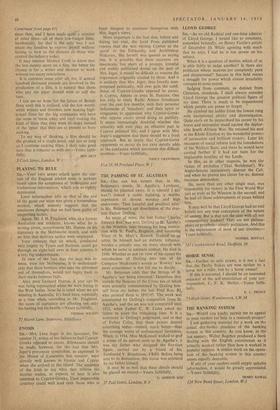THE PASSING OF ST. AGATHA'S Stn,—One can but mourn that,
in Mr. Betjeman's words, St. Agatha's, Landport, should be planned away. It is (should 1 say was?) indeed a noble building, a worthy expression of devout worship and high endeavour. 'That forceful and practical saint' is Mr. Betjeman's apt description of the reso- lute Father Dolling.
An uncle of mine, the late Father Charles
Edward Roc, was with Dolling at St. Agatha's in the Nineties, later forming his long associa- tion with St. Paul's, Brighton, and becoming Vicar of St. Mary's, Busted. Trained as an artist, he himself had an ;esthetic influence, besides a priestly one, on every church with which he came in intimate contact. He died in 1940. Whether or not (in view of his name) the introduction of Dolling into one of Sir Compton Mackenzie's novels as 'Rowley' was mere coincidence is not for me to decide.
Mr. Betjeman adds that the fittings of St.
Agatha's 'are being removed.' Doubtless they include the Stations of the Cross, ten of which were specially commissioned by Dolling him- self from ,my father, the late Fred Roe, RI, who painted them in 1892-95. The work was interrupted by Dolling's resignation from St. Agatha's, and the set was not completed until
1922, when Father C. W. Coles asked my father to paint the • remaining four. It is a testimony to Dolling's judgement, and to that of Father Coles, that these priests desired something better—indeed, much better—than the average wares of ecclesiastical furnishers. When, in 1934, Miss McKinnell wished to give a statue of its patron saint to St. Agatha's, it was my father who designed the five-foot
figure, carried out by a friend of his, - Ferdinand V. Blundstone, FRI3S. Before being sent to its destination, this statue was coloured by my father himself.
It may be as well that these details should be placed on record.—Yours faithfully, F. GORDON ROE'


































 Previous page
Previous page